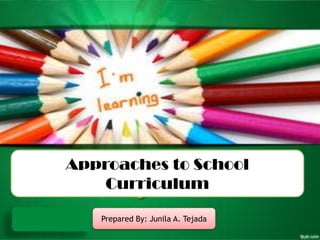
Approaches to School Curriculum
- 1. Approaches to School Curriculum Prepared By: Junila A. Tejada
- 2. Desired Learning Outcomes • Describe the different approaches to school curriculum • Explain by examples how the approaches clarify the definition of curriculum • Reflect on how the three approaches interrelate with each other
- 3. Three Ways of Approaching a Curriculum • Curriculum as a Content • Curriculum as a Process • Curriculum as a Product
- 4. Three Ways of Approaching a Curriculum • Curriculum as a Content • Curriculum as a Process • Curriculum as a Product
- 5. 1. Curriculum as a Content or Body of Language Focus will be the body of knowledge to be transmitted to students using appropriate teaching method. The likelihood of teaching will be limited to acquisition of facts, concepts and principles of the subject matter; however , the content can also be taken as a means to an end.
- 6. Ways of presenting the content in the curriculum • Topical approach- much content is based on knowledge , and experiences are included. • Concept approach - fewer topics in clusters among major and sub-concepts and their interaction, with relatedness emphasized; • Thematic Approach- combination of concepts that develop conceptual structures • Modular Approach- leads to complete units of instruction
- 7. Criteria in Selection of Content (Scheffer, 1970 in Bilbao, et al 2009) Significance Validity Utility Learnability Feasibility Interest
- 8. Significance • Content should contribute to the ideas, concepts, principles and generalization that should attain the overall purpose of the curriculum. • Content becomes the means of developing cognitive, affective, or psychomotor skills of the learners.
- 9. Validity • Authenticity of the subject matter forms its validity. • There is a need for validity check and verification at a regular interval, because content may not continue to be valid.
- 10. Utility • Usefulness of the content in the curriculum is relative to the learners who are going to use this.
- 11. Learnability • The complexity of the content must be within the range of the learners.
- 12. Feasibility • Can the subject be learned within the time allowed, resources available, expertise of the teachers and the nature of the learners? • Are the contents of learning which can learned beyond the formal teaching-learning engagement? • Are there opportunities to learn these?
- 13. Interest • Will the learners take interest in the content? • What value will the contents have in present and future life of the learners? • Interest is one of the driving forces for the students to lean better.
- 14. Guide in the Selection of the Content in the Curriculum • Commonly used in the daily life • Appropriate to the maturity levels and abilities of the learners • Valuable in meeting the needs and competencies of the future career • Related to other subject fields or discipline for complementation and integration • Important in transfer of learning to other disciplines
- 15. BASIC principles of Curriculum Content In 1952, Palma proposed the principle BASIC as a guide in addressing CONTENT in the curriculum. Balance. Content should be fairly distributed in depth and breadth. Articulation. As the content complexities progresses with the education levels bridging should be provided Integration Continuity Sequencing. The logical arrangement of the content refers to sequence or order Content in the curriculum does not stand alone or in isolation. It has relatedness to other contents. Curriculum should continuously flow as it was before, to where it is now, and where it will be in the future,
- 16. Three Ways of Approaching a Curriculum • Curriculum as a Content • Curriculum as a Process • Curriculum as a Product
- 17. 2. Curriculum as a Process Curriculum hapens in the classrom as the questions as by the teacher and learning activities engaged in by the students. lThe process of the teaching and learning process becomes the central concern of teaching to emphasize critical thinking, thinking meaning-making and heads on, hands-on doing and many others. There are the ways of teaching, ways of managing the content, guiding learning, methods of teaching and learning and strategies of teaching or delivery modes.
- 18. When curriculum is approached as a PROCESS, guiding principles are presented• Curriculum process in the form of teaching methods or strategies are means to achieve the end. • There is no single best process in method. • Curriculum should stimulate the learners' desire to develop the cognitive, affective, psychomotor domain in each individual. • In the choice of methods, learning and teaching styles should be considered. • Every method or process should result to learning outcomes which can be described as cognitive, affective, and psychomotor. • Flexibility in the use of the process or methods should be considered. • Both teaching and learning are the two important processes in the implementation of the curriculum.
- 19. Three Ways of Approaching a Curriculum • Curriculum as a Content • Curriculum as a Process • Curriculum as a Product
- 20. 3. Curriculum as a Product Central to the approach is the formulation of behavioral objectives stated as intended learning outcomes. These learned or achieved learning outcomes are demostrated by the person who has meaningful experiences in the curriculum. All these result of planning, content and processes in the curriculum.
